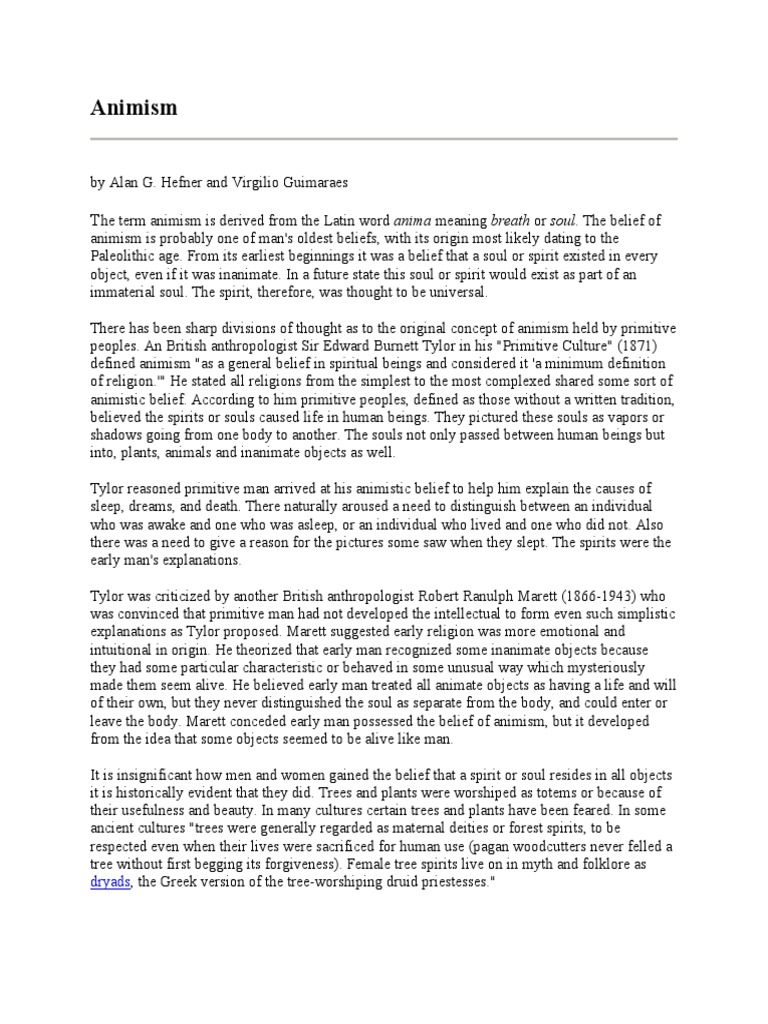Animism, often characterized by the belief that objects, places, and creatures all possess a distinct spiritual essence, offers a fascinating lens through which to examine our relationship with the natural world. This perspective invites contemplation of the question: What if every tree, stone, and stream has a consciousness of its own? This inquiry opens a multidimensional dialogue within cultural relativism, challenging the often anthropocentric paradigms that prevail in modern societies. Thus, embarking on an exploration of animism entails navigating the rich tapestry of human belief systems and their implications for our understanding of existence.
First, it is essential to delineate what animism fundamentally entails. Derived from the Latin term ‘anima,’ meaning ‘soul’ or ‘spirit,’ animism posits that non-human entities—be they flora, fauna, or inanimate objects—are imbued with life and intention. This belief system is prevalent in many Indigenous cultures globally, where the interrelation between humans and nature is viewed as a reciprocal partnership rather than a hierarchical dominance. In these societies, the spiritual significance of elements in the environment fosters a profound respect and a sense of kinship with the world.
In understanding animism, one must recognize its inherently cultural roots. Rather than a monolithic doctrine, animism reflects a multitude of practices and beliefs shaped by specific environmental contexts and historical experiences. Each culture’s interpretation of the spirit-life of the world is informed by local ecology, shaping the rituals, customs, and narratives that flourish within that milieu. Thus, while the essence of animism may be universally applicable, its expressions are as varied as the cultures that embrace it.
Consider the complex cosmology of the indigenous peoples of the Amazon rainforest, where the myriad species of flora and fauna are often regarded as relatives rather than mere resources. Here, the lives of humans and spirits can intertwine, culminating in ceremonies that honor the life-force permeating their environment. In contrast, the Aboriginal Australians possess a rich tradition of Dreamtime, wherein the land itself is considered a living tapestry of ancestral narratives, embodying the spirits of those who came before. Within such frameworks, the challenge arises: how might contemporary societies reconcile their disconnection with nature to foster a more animistic worldview?
Modernity, characterized by industrialization and urban expansion, tends to foster a disconnect from the natural world. This estrangement can engender an overarching sense of anthropocentrism, whereby human interests eclipse the intrinsic value of non-human entities. The implications are profound; as modern civilization propagates this detachment, the resultant ecological degradation poses existential threats to both nature and humanity. The animistic perspective, thus, serves as a counter-narrative, challenging us to rethink our engagement with the world. How do we cultivate a sense of interdependence with nature amidst the prevailing tide of commodification?
Ethnographic studies reveal that animistic beliefs encourage sustainable practices and ecological stewardship. In societies where the land and its resources are revered, there is a palpable dedication to preserving biodiversity and maintaining ecological balance. This is evident in practices such as rotational farming, sacred groves, or community governance of natural resources, all underpinned by a deep spiritual reverence for the land. By adopting these principles, modern society can glean insights into making choices that align more closely with environmental sustainability.
Yet, engaging with animism does not entail wholesale appropriation of Indigenous beliefs; rather, it invites an introspective dialogue on the essence of spirituality in a global context. This raises a pertinent question about cultural relativism: Can the principles of animism be integrated into modern livelihoods without trivializing their significance? The potential for misappropriation necessitates careful consideration of the ethics surrounding such integration. Authentic understanding requires not only acknowledgment of the value of traditional knowledge but also a commitment to honor the voices and experiences of those who practice animism.
Animated by the belief that every aspect of the world is alive, animism encourages individuals to foster a sense of wonder and stewardship towards their surroundings. It invites an emotional connection that can be transformative, leading to a more harmonious coexistence with nature. As we navigate the complexities of the contemporary world, the animistic worldview asserts that recognizing the spirits within all things enriches our understanding of life’s interconnectedness.
In closing, the exploration of animism through a cultural relativism lens reveals the significance of spirituality in shaping human interactions with the environment. As societies face increasing ecological crises, the animistic perspective offers profound insights, encouraging a reconnection with the natural world. Perhaps the challenge lies not solely in understanding animism but in actively embodying the principles of respect, kinship, and interdependence that underpin it. By doing so, humanity may rediscover its place within the tapestry of life, fostering a future that celebrates the spirit inherent in all things.
